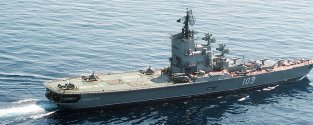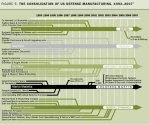Christmas mood is still around so I'll allow myself one more:
In Soviet doctrine the carriers [...]
No aircraft carriers in Soviet doctrine - only
aviation cruisers. Nothing to do with Montreux convention because they could be built in Leningrad instead of Mikolayiv. This is just a myth repeated by people who prefer cheap sensationalism to logical thinking.
Soviet planners didn't want to waste resources on aircraft carriers but helicopter carriers were necessary. Soviet aviation cruisers were ASW helo carriers that only later were expanded into general aviation carriers. In late 50s/early 60s through espionage Soviets became aware of US advantage in sonar and submarine technology so they developed "bastion" strategy and used aggressive ASW in that area as a counter. Gorshkov's ideas were as much a psy-op and his personal fiefdom claim as an attempt to expand into even more aggressive defensive posture to deny USN access to the Arctic, except that the last one required more resources than USSR was able to commit to such exotic purpose.
Moskva and
Leningrad were commissioned 1967 and 1969 but they were quick, cheap and bad design - 15 000 t full, top heavy and unstable in high sea states.
 Kiev
Kiev (41 000 t) was developed immediately afterward, laid down in 1970 and commissioned in 1975. It was much better and could carry Yak-38. Kievs also carried 8 nuclear-capable P-500 missiles making them multirole warships. But their primary role was
helo carrier and not Yak carrier.

Four ships were built and the fifth was supposed to be the first CATOBAR design. Politburo didn't like that and forced a S/VTOL design but Yak-38 was a complete disaster and that's why Kuznetsov is "
helicopter carrier with full deck because Yak-38 doesn't work".
There is no "aircraft carrier" in Russian doctrine because there has never been one in Soviet doctrine so
as institution Russia military doesn't know what an aircraft carrier is and how it works. In institutions
institutional and not individual knowledge is what matters.
USN doctrine structures the task force around an aircraft carrier. Soviet doctrine structures the task force around a missile carrier - SSBN or CGN. Soviet doctrine is
jeune ecole avec grands navires.
Kuznetsov's infamous mission to Syria was completely against Soviet doctrine. It was Putin attempting to mimic US doctrine because
to him Kuznetsov looked like a carrier. But if it was a carrier then a carrier doctrine would be in effect and all the relevant elements would be maintained much like the nuclear submarines were maintained despite economic collapse
because of the doctrine.
The Russian government started by buying what was available to replace existing outdated hardware. What was available was basically what used to be exported. And then they made investments into some programs for capabilities they needed which the export market did not want like the Su-34 or would not fund like the Su-57.
I meant choices like:
- Ka-52 with Vikhr instead of Mi-28N with Ataka
- Su-34 instead of Su-30 with targeting and jamming pods (and modifications to allow for spare fuel tanks!)
- Tu-160 and Tu-22M over Tu-95
- trying to develop advanced AIP for Lada instead of Stirling module for 636.3
- the many missiles manufactured by different companies
- giving shipbuilding orders to shipyards in different regions regardless of competency
For example of politics: Su-34 vs Su-30 is Novosibirsk vs Komsomolsk-on-Amur. Su-30 could be produced in both, but that would create internal conflict and obstruction that could only be resolved by consolidation - which then would require reduction and the circle is closed.
I won't say there aren't special interests and lobbies in the Russian MIC, but if their lobbying power was that great, you wouldn't have seen so many companies either shuttered or downsized even after Putin was President.
US MIC was told they have to consolidate or die in 1992 and was done consolidating before Iraq War.

Putin became president in 2000 and did all he could to avoid proper consolidation until there was no other way to prevent bankruptcy. He expanded facilities for political reasons in one region while in another there was still an active facility in the red but with administrative staff still on payroll.
He's not responsible for the condition of Russian industry - it
was worse in the 90s - but he didn't fix the problem only kept it under control of the state and blamed "foreign intervention" for domestic corruption in the 90s so that he could keep the corrupt structure under control and not have to declare open warfare against them that would cost him his position.
The Tu-160 is a visible demonstration of Russian military power. And it has been used to deflate tensions all over the place for example by flying to Venezuela and Cuba.
USAF can send more refuelers to keep Super Hornets in the air for longer than Tu-160 can stay supersonic while fleeing Venezuela or Cuba. Flying the roundel is purely about
presence and thus Tu-95 would achieve the same effect at lower cost.
Russia already had the MiG Skat and has the S-70 Okotnik. The Skat predates the nEUROn. The Tu-95 has been modernized into the Tu-95MSM with new engines and electronics. And the PAK DA is supposed to be a flying wing. So they are in fact doing what you want.
Skat came out
after nEUROn and Okhotnik came even later. Sukhoi's constant attempts to undermine Mikoyan aside - that work should be done independently as a strategic program with PAK-DA involved.
PAK-DA financing began in 2008 and after fourteen years it still exists only on paper with prototypes planned for 2023-26. For comparison: B-2 flew with colors (not formally in service due to secrecy) 14 years after formal start of the program. PAK-DA will take 20 years if the 2028 deadline is met, which is doubtful.
Also PAK-DA will replace Tu-95 leaving expensive Tu-160M2 and Tu-22M3M to complement it. The cheapest stand-off bomber is being retired and the expensive ones are kept.
Tu-95MSM is a symbolic upgrade. I have no time to describe what I had in mind but I imagined continued service well into the 2050s.
You seem to think the Tu-22M3M is just supposed to be a bomber and neglect its capabilities in anti-shipping attacks
Tu-22M became a maritime bomber because it failed as a strategic bomber against competition from rockets but production needed to be maintained for political and economic reasons. Naval Aviation took it because they had no other option. For example nobody was willing to give Naval Aviation Tu-95MS and Kh-55 so they had to make do with Tu-22M and Kh-22.
Backfire was made in this strange short blip of an era between 1970 and 1990 when aviation technology was advanced enough to develop a Tu-22M but computers weren't advanced yet to make good radar and good guidance possible. It's the same era that gave us supermaneuverable fighters a couple of years before active seeker BVR missiles. It was a silly time and that's why most designs from that era became obsolete very quickly - they were too advanced/expensive in the wrong area and not advanced enough in others to make upgrades unaffordable (see: F-14)
Tu-160, Tu-22M were kept in service because they were the "modern" design in production most recently. They were also the less efficient, more expensive design compared to Tu-16 or Tu-95.
I agree they could use some kind of turboprop airframe with long endurance. But they aren't the only ones not investing much into turboprops. Most of the world has moved away from turboprops.
Choosing Tu-95 is means of
reducing cost. Your first instinct is to choose a new airframe i.e. to
increase cost.
The world hasn't moved away from turboprops. They are simply not as efficient in terms of space/area used to generate force/thrust and that has consequences to fuel economy.
Commercial aircraft have fuel/payload ration as focus and the airframe is low wing for aerodynamic reasons. Commercial aircraft drive the economies of production of components. Turbofans are therefore more efficient in economies of scale even though they are more expensive to make and maintain per unit.
However: C-130J, A-400M, MV-22, V-280, all heavy helicopters - all turboprops. The key is to use most efficient solution for each problem.
The supersonic platforms can be used to increase the launch speed of hypersonic missiles.
Scramjets require 1-2Ma for launch. Ramjets don't and deliver speeds of 3-6Ma. Supersonic bombers can't reach 1,5Ma with payload. Etc.
----
Ok, that's enough for now.




